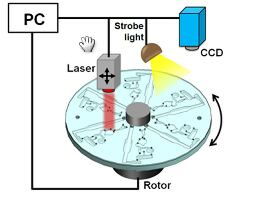As the centrifugal microfluidic device spins it performs the three main steps of pathogen detection: DNA extraction, isothermal recombinase polymerase amplification (RPA) and detection.
The disc is made up of six parts which contain channels and chambers to do the steps in pathogen detection.
When a sample is added to the center of the machine, the disc rotation forces the solution outward into the channels of each slice, said the researchers.
The process involves lysis of sample solution by laser irradiation, amplification of RPA mixture for 20 minutes at 40°C, metering of RPA product for dilution, mixing with metered RPA product and PBST solution, transfer of mixed solution to detection chamber and absorption of sample solution while the disc is in stationary mode.
Testing device
Rare cells in large volumes of phosphate-buffered saline (PBS) and milk samples were enriched before loading onto the disc by using antibody-coated magnetic beads.
To demonstrate the successful operations of the disc for Salmonella detection, they tested Salmonella-spiked in PBS and milk (101–106 cfu/mL).
A laser diode was used for wireless control of valve actuation, cell lysis, and noncontact heating in the isothermal amplification step.

Final detection used lateral flow strips by direct visual observation; detection limit was 10 cfu/mL and 102 cfu/mL in PBS and milk, respectively.
Selectivity was evaluated with the milk samples spiked with Staphylococcus aureus, Enterococcus faecium, E. coli, and Pseudomonas aeruginosa (104cfu/mL).
Only one strip sensor tested with Salmonella sample showed a positive line while other pathogens showed no signal the same as the negative control sample, said the researchers.
The fluidic chambers for cell lysis, isothermal amplification, metering, dilution, and detection were located at the bottom of the disc.
The ferrowax microvalves were at the top of the disc and were actuated on demand by laser irradiation.
A computer controls the spinning motor, a laser to operate the ferrowax microvalves, local heating of the amplification chamber, and a strobe light and a camera for the readout of the fluidic transfer on the rotating disc.
Current processes
Conventional methods for detection of foodborne pathogens, based on cell cultivation, require at least three to four days to yield presumptive results and up to seven days to yield confirmatory results, said the researchers.
Techniques such as polymerase chain reaction (PCR), enzyme immunoassay, fluorescence resonance energy transfer (FRET) and microarray have been developed but they require complicated manual steps, specially trained personnel, and expensive equipment.
“In our system, selective enrichment of the target from a large volume of the sample is achieved through immunomagnetic separation,” said the researchers.
Source:Analytical Chemistry, 2014, 86(8), pp 3841–3848
Online ahead of print, DOI: 10.1021/ac403971h
“Fully Integrated Lab-on-a-Disc for Nucleic Acid Analysis of Food-Borne Pathogens”
Authors: Tae-Hyeong Kim, Juhee Park, Chi-Ju Kim, and Yoon-Kyoung Cho
